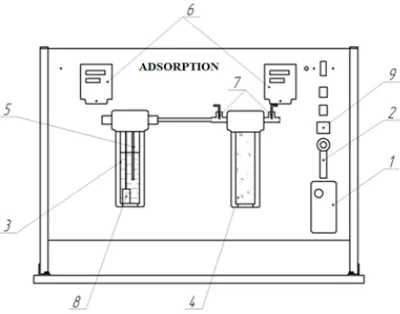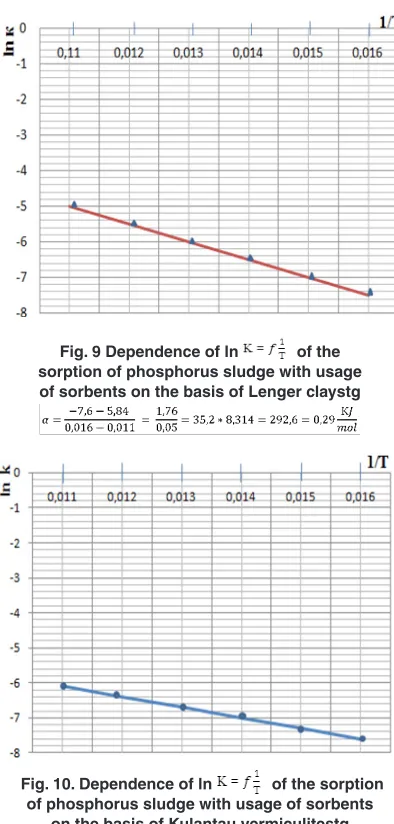ORIENTAL JOURNAL OF CHEMISTRY
www.orientjchem.org
An International Open Free Access, Peer Reviewed Research Journal
ISSN: 0970-020 X CODEN: OJCHEG 2018, Vol. 34, No.(3):
Pg. 1451-1456
Kinetic Studies of Sorption and Separation of Phosphorus
with Usage of Sorbents on the Basis of Natural Clays
A. S. TLEUOv, S. D. ARYSTANOvA*, S. T. TLEUOvA, A. A. BOLYSBEK,
O. P. BAIYSBAY and A. S. ABzHANOvA
M. Auezov South Kazakhstan State University, Shymkent, Republic of Kazakhstan. *Corresponding author E-mail: Jasiko2008@mail.ru
http://dx.doi.org/10.13005/ojc/340335
(Received: March 04, 2017; Accepted: April 30, 2017)
ABSTRACT
Kinetic researches of sorption separation of phosphorus from phosphorus sludge with usage of sorbents on the basis of native silica-alumina clays in the low-temperature area are limited with adsorption processes and sublimation. Bentonites, vermiculites and refractory clays are chosen for carrying out researches. The high-quality sorbents resistant to work in an aqueous and aggressive environment are obtainedon their basis. In practical conditions the kinetics process can be defined not only by the speed of actually chemical reaction of nucleation or internal diffusion, but also with other phenomena. When the most slow stage of chemical interaction in the mix solid – fluid – gas is recrystallization and adsorption that is characteristic for our researches, naturally change of sorption speed defines kinetics of interaction system.
Key words: Kinetics, Phosphorus sludge, Sorbent, Sorbtion, Alumina silicate, Activation energy.
INTRODUCTION
The problem of environment protection is one of the most important problems today1. As
waste is potential secondary material resources, the operating system of removal of technogenic waste leads to irrevocable loss of valuable secondary material resources, energy and land resources2.
The production of sorbents3 and catalysts4 on
the basis of clayraw materials restrains the fact that today influence of modifying on structural, thermal, adsorption and catalytic properties of
such materials is insufficiently investigated. The main technogenic waste of phosphoric production are phosphorus sludge which are formed on phosphorus condensation stages5-11. In compliances
with the modern representations, phosphorussludge represents phosphorus emulsion in water stabilized with fine-grained solids12-13.
Considering phosphorus sludge as stabilized with highly active pollution of emulsion in water, the way of phosphorus separation is chosen from sludge with usage of solid porous sorbents
on the basis of natural refractory, bentonitic clays and vermiculites14. The processing of phosphorus
sludge with sorption method provides high extent of phosphorus separation, and usage of native, available natural minerals allows to reach considerable economic and ecological effect for this purpose.
MATERIALS AND METHODS
The experimental datas were processed with Rotinyan-Drozdov's equation for definition of chemical process of phosphorus separationfrom phosphorus sludge with usage of sorbents on the basis of native silica-alumina clays.
(1)
where – M - efficient constant of speed process; β – drag coefficient
Rotinyan-Drozdov's equationis used when studying heterogeneous processes and efficient specific reaction rate characterizes the processes beginning on all surface of the heterogeneous system. At the same time finding of drag coefficient defines influence of resultants on the interaction speed process.
Studying of the kinetics of adsorption chemical process was carried out at temperatures of 60, 70, 80, 90 0C with isothermal endurance 30,
60, 90, 120, 150 min. with usage of sorbents on the basis of clays from Kazakhstan’s deposits Darbaza and Lenger and also vermiculite of the Kulandy field which is also located in South Kazakhstan.
Laboratory researches of phosphorus separation from sludge with usage of sorbents on the basis of native clays and vermiculite were carried out on the installation given on the Figure 1.
The work was carried out on the installation which works according to the following scheme. The phosphorus sludge admits from the compressor 1. Through a flow meter with the needle nozzle. 2. Further it passes through water in the flask.
3. The moisture content of air is measured with the sensor of the relative humidity 7. Passing the flask with absorber, cleaned gas with phosphorus is collected in the flask with water 4. Parameters of humidity and air temperature are displayed on digital devices TPM200 (6). The water temperature regulation is carried out in TC4S (9). Maximum withstand water temperature is 90 0C.
RESULTS AND DISCUSSION
The experimental data of the sorption of phosphorus sludge obtained on the laboratory installation are given in Fig. 2-4. Dependences of extent of separation of phosphorus from temperature and time are defined on the residual content of phosphorus in the termination of adsorbed products.
Fig.1. Laboratory installation for adsorption process
Fig. 2. The influence of temperature and durations of experiences on the extent of phosphorus separation
1453
ARySTANOVA
et al., Orient. J. Chem., Vol. 34(3), 1451-1456 (2018)The analysis of graphic data confirms direct dependence of extent of phosphorus separationon the temperature and isothermal endurance of the process. The maximal extent of phosphorus separationup to 98% is reached when using sorbents on the basis of the Darbaza clay modified with sulfuric acid 0,25M.
The experimental data of extent dependence of phosphorus separationfrom phosphorus sludge with various sorbents at the studied temperatures 80-90 0C and duration 30 -150 min. mathematically
processed with Rotinyan– Drozdov's equation are presented in Tables 1-3:
Fig. 3. The influence of temperature and duration of experiences on the extent of phosphorus separation
from sludge with usageof sorbents on the basis of refractory clays
1 – t=60 0C; 2 – t =70 0C; 3 – t =80 0C; 4 – t =90 0C
Fig. 4. The influence of temperature and durations of experiences on the extent of phosphorus separation from sludge with usage of sorbents on the basis of
vermiculites 1 –t=60 0C;2 –t =70 0C; 3 –t =80 0C; 4 – t =90 0C
Table 1: Mathematical processing of experimental data with Rotinyan– Drozdov's
equation of sorption of phosphorus sludge sorbents on the basis of Darbaza bentonitic clay
T, 0C α t
60 0,30 1,43 0,36 30 0,012 0,010 0,55 2,2 0,81 60 0,016 0,009 0,76 4,7 1,52 90 0,015 0,008 0,85 6,7 1,92 120 0,016 0,007 0,86 7,1 1,96 150 0,013 0,005 70 0,32 1,47 0,38 30 0,011 0,010 0,60 2,5 0,92 60 0,018 0,010 0,83 5,8 1,77 90 0,017 0,009 0,90 0,10 2,33 120 0,018 0,007 0,91 11,1 2,44 150 0,014 0,006 80 0,35 1,54 0,43 30 0,014 0,012 0,65 2,85 1,04 60 0,020 0,010 0,88 8,33 2,12 90 0,021 0,009 0,95 20 2,99 120 0,024 0,008 0,96 25 3,22 150 0,019 0,006 90 0,38 1,61 0,47 30 0,014 0,013 0,73 3,70 1,31 60 0,026 0,012 0,94 16,6 2,77 90 0,028 0,010 0,98 50 4 120 0,032 0,008 0,99 100 4,6 150 0,030 0,006
Table 2: Mathematical processing of experimental data with Rotinyan– Drozdov's equation of sorption of phosphorus sludge sorbents on the basis of Lenger (refractory) clays
T, 0C α t
On the basis of mathematical calculation datacomponents of the Rotinyan– Drozdov's e q u a t i o n a r e bu i l t g r a p h i c d e p e n d e n c e s w h i c h a r e p r e s e n t e d i n Figures 5-7.
The analysis of graphic dependences shows that the studied process is described well with Rotinyan–Drozdov's equation that testifies rectification of the experimental curve dependences of extent of phosphorus separationdepending from various factors.
The drag coefficient β1 β2β3is calculatedon tg
fof each straight line. The efficient specific reaction rate for each temperature was defined from the schedule at =0.
The activation energy defines influence of temperature on the speed process. In practice the calculation "apparent" activation energy for the Arrhenius equation is widespread:
K=A0e-E⁄RT (2)
Fig. 5. Dependence of Time (t) on Darbaza bentonitic clay
1-60 0C, 2-70 0C, 3-80 0C, 4-90 0C.
Fig. 7. Dependence of Time (t) on for Kulantau vermiculite
1-60 0C, 2-700C, 3-800C, 4-900C Fig. 6. Dependence of Time (t)on for
Lenger clays
1-60 0C, 2-70 0C, 3-80 0C, 4-90 0C
Table 3: Mathematical processing of experimental data with Rotinyan–Drozdov's equation of sorption of phosphorus sludge sorbents on the basis of Kulantau vermiculite
T, 0C α t
1455
ARySTANOVA
et al., Orient. J. Chem., Vol. 34(3), 1451-1456 (2018)where E – activation energy, kJ/mol.
As concentration of reactants does not depend on the temperature, the same ratio turns out also for the speed process (V).
V=V0e-E⁄RT (3)
That is the more than E the quicker reaction rate with temperature increasing E is defined from expression:
(4)
where 4.575 is the product of conversion factor from natural logarithm into decimal 2.303 and universal gas constant R1.9865 [kal/Mol∙K]
From graphic dependences of ln (Fig. 8-10) given for each type of sorbents were calculated values of apparent activation energy (E app.), which results are given in the table of indexes:
CONCLUSION
The analysis of the obtained values of E app. extents of phosphorus separationfrom the type of the sorbent show that the maximal extent
Table 4: value E each for different types of sorbents
No Name of Drag coefficient kJ/mol the sorbent at T
0C β
1 Darbaza clay 60 0,007 83,14
70 0,015 80 0,028 90 0,039
2 Kulantau 0,02 2,078
vermiculite60 70 0,04
80 0,06
90 0,08
3 Lenger clay 60 0,03 0,29
70 0,05
80 0,07
90 0,08
The graph of dependence of ln is presented in Figures 8-10
Fig. 8. Dependence of ln of the sorption of phosphorus sludge with usage of bentonitic sorbentstg
Fig. 9 Dependence of ln of the sorption of phosphorus sludge with usage of sorbents on the basis of Lenger claystg
Fig. 10. Dependence of ln of the sorption of phosphorus sludge with usage of sorbents
of phosphorus separationis reached when using sorbents on the basis of Darbaza clay. "Apparent" activation energy has maximal value 83,14 KJ/mol, the drag coefficient β reaches 0,07 - 0,039 that demonstrates course of process of the sorptionphosphorus from sludgein transient regime with considerable influence of diffusion factors. The sorption process at using Lengerclay and Kulantau
vermiculite is characterized with E app from 0,29 to 2,078 KJ/mol that corresponds about course of process in diffusion area.
ACKNOwLEDgMENT
The work was financially supported by a project GF 68-31 of theMinistry of Education and Science of the Republic of Kazakhstan.
REFERENCES
1. Gholipour, H.F., Farzanegan, M.R. Const Polit
Econ., 2018, 29, 20-39.
2. Hoornweg, D., Bhada-Tata, P., Urban Dev
Ser Knowl Pap, 2012, 15, 1-98
3. Su, Ch., Duan, L., Donat, F., Anthony, E. J.,
Appl Energy., 2018, 210, 117-126.
4. Soni , V.K., Sharma, P. R., Choudhary, G., Pandey, S., Sharma, R.K. , ACS Sustainable
Chem. Eng., 2017, 5 (6), 5351–5359
5. Cordell, D., Rosemarin, A., Schröder, J.J., Smit, A.L., Chemosphere., 2011, 84, 747-758
6. Donatello, S., Cheeseman C., Waste Manag.,
2013, 33, 2328-2340.
7. Li, R., Zhao, W., Li, y., Wang, W., Zhu, X., J.
Hazard. Mater., 2015, 283, 423-431.
8. Lapa, N., Barbosa, R., Lopes, M.H., Mendes, B., Abelha, P., Gulyurtlu, I., J. Santos Oliveira,
J. Hazard. Mater., 2007, 147(1–2),175-183.
9. Nakakubo, T., Tokai, A., Ohno, K., J Clean
Prod., 2012, 32, 157-172.
10. Garrido-Baserba, M., Molinos-Senante, M., Abelleira-Pereira, J.M., Fdez-Güelfo, L.A., Poch, M., Hernández-Sancho, F., J Clean
Prod., 2015, 107, 410-419.
11. Rodríguez, N.H., Martínez-Ramírez, S., Blanco-Varela, M.T., Donatello, S., Guillem, M., Puig, J., Fos, C., Larrotcha, E., Flores, J.,
J. Clean. Prod., 2003, 52, 94-102.
12. Herzel, H., Krüger, O., Hermann, L., Adam, C., Science of The Total Environment, 2016,
542( B), 1136-1143.
13. Cieslik, B., Konieczka, P., Journal of Cleaner
Production., 2017, 142(4), 1728-1740.
14. Tleuov, A.S., Tleuova, S.T., Altybayev, Zh.M., Suigenbayeva, A.Zh., Orient. J. Chem., 2016,



